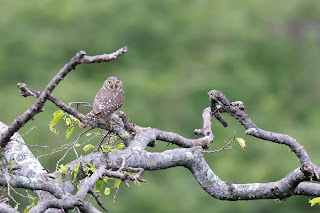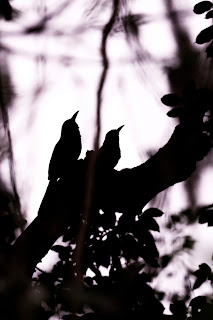Having had our original plans for the day fall apart at the last moment, we spent today exploring the habitat in the south of Ecuador. Although we had two days reserved to explore the Tumbes, the extra day we had from not being able to go up the mountain afforded us some more time to explore other areas of this localised habitat, and we were able to use that to our advantage.
We spent the morning in an area called El Empalme, and while
many of the species here are common Tumbes species, there are others that are
not, specifically the White-headed Brushfinch which is more range-restricted and
difficult to encounter than other species. The valley here is a stronghold for
the species, especially in Ecuador, but they did not come easy. It took us a
good three hours before we found our first pair, although the next pair
followed quickly after. They showed well in the end, making all our effort
worthwhile.
In exploring the area we also found a number of other good
Tumbes species, many that we would encounter later at the next site, but others
that we would not. The unspectacular Tumbes Hummingbird was a nice bonus
species, although it only perched at a distance. It was good to see the
Peruvian Pygmy Owl as well, which showed nicely during the morning. Other good
birds we saw included Collared Antshrike, Pacific Parrotlet, Scrub Blackbird,
Ecuadorian Piculet and Baird’s Flycatcher.
This habitat is much hotter and generally drier than other Andean
environments, so by late morning we continued on our way, heading south to the
town of Macara, which would be our base for the next few days. Here we ran a
few errands, filling the car, withdrawing cash and stocking supplies. We also
had a quick nap in the hotel we chose, which set us up nicely for the afternoon.
Because the main reserve in this area requires prior booking,
we had quite limited options for where to bird during the afternoon. We decided
to take the 40 minute drive to the town of Sozoranga, which is where we would
be able to find Chestnut-collared Swallow, a regional endemic otherwise easily missed,
and not really fitting into our itinerary at any other point. And this journey
was well worth it, with fantastic views of the birds as the visited nests to
feed chicks, with nestlings ranging from newly borns to almost fledgling. The
structure of the nests themselves was spectacular, with fantastic entrances built
out of clay.
For the rest of the afternoon we birded a dirt road not so far from the main reserve. During the late afternoon and early evening, we managed to round off a good numbers of commoner Tumbes species such as Ecuadorian Trogon, Unicolor Becard and Tumbes Pewee. Although not rare, as we heard them throughout, it was good to actually see a Pale-browed Tinamou, one of the key species we wanted to see during our time in this habitat. Since it was late evening we also decided to stay out after dark and try for the Peruvian Screech Owl, another endemic in the region. Since it is a screech owl, we hoped it would be easy to find, and we were not wrong. After dark we waited no more than ten minutes before and owl came and perched exceptionally well, rounding off another brilliant day birding.
El Empalme: Croaking Ground Dove, White-tipped Dove, Eared Dove, Tumbes Hummingbird, Amazilia Hummingbird, Black Vulture, Turkey Vulture, Pacific Pygmy Owl, Ringed Kingfisher, Ecuadorian Piculet, Scarlet-backed Woodpecker, Pacific Parrotlet, Red-masked Parakeet, Collared Antshrike, Streak-headed Woodcreeper, Pacific Hornero, Southern Beardless Tyrannulet, Baird's Flycatcher, White-browed Gnatcatcher, House Wren, Fasciated Wren, Long-tailed Mockingbird, Thick-billed Euphonia, White-headed Brushfinch, Scrub Blackbird, Golden Grosbeak, Blue-grey Tanager, Ash-breasted Sierra Finch, Saffron Finch,
Sozoranga: Feral Pigeon, Eared Dove, Striped Cuckoo, Turkey Vulture, Swallow-tailed Kite, Blue-and-white Swallow, Grey-breasted Martin, Chestnut-collared Swallow, House Wren, Great Thrush, Scrub Blackbird, Blue-grey Tanager,
Via Achima: Pale-browed Tinamou, Blue Ground Dove, White-tipped Dove, Pauraque, Amazilia Hummingbird, Black Vulture, West Peruvian Screech Owl, Pacific Pygmy Owl, Ecuadorian Trogon, Whooping Motmot, Ecuadorian Piculet, Scarlet-backed Woodpecker, Laughing Falcon, Pacific Parrotlet, Red-masked Parakeet, Collared Antshrike, Streak-headed Woodcreeper, One-colored Becard, Tumbes Pewee, Chivi Vireo, White-browed Gnatcatcher, House Wren, Fasciated Wren, Plumbeous-backed Thrush, Thick-billed Euphonia, Saffron Siskin, Black-capped Sparrow, Tropical Parula, Grey-and-gold Warbler, Golden Grosbeak, Blue-grey Tanager, Blue-black Grassquit, Variable Seedeater, Streaked Saltator,






























No comments:
Post a Comment